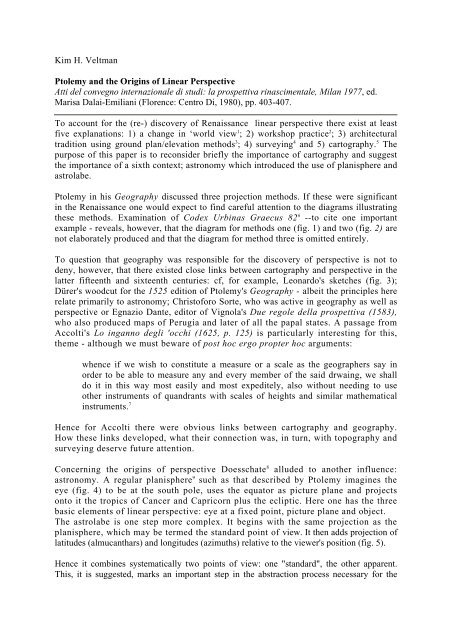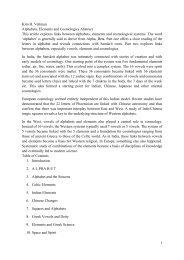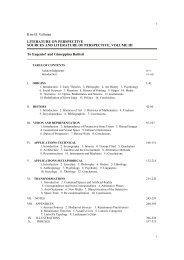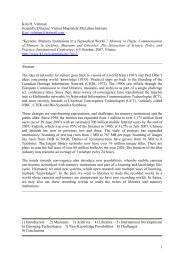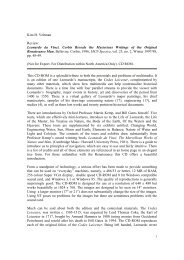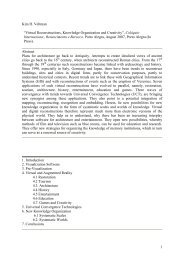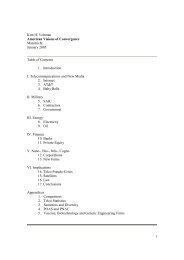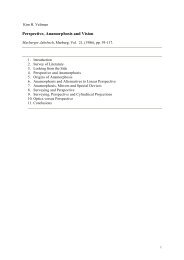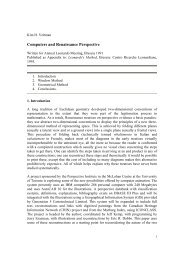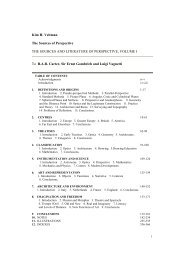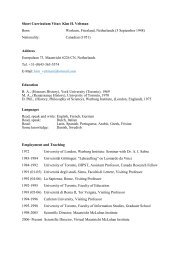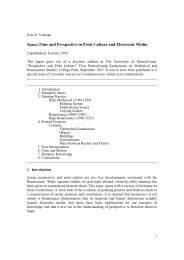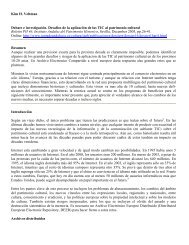Kim H. Veltman Ptolemy and the Origins of Linear Perspective Atti ...
Kim H. Veltman Ptolemy and the Origins of Linear Perspective Atti ...
Kim H. Veltman Ptolemy and the Origins of Linear Perspective Atti ...
You also want an ePaper? Increase the reach of your titles
YUMPU automatically turns print PDFs into web optimized ePapers that Google loves.
<strong>Kim</strong> H. <strong>Veltman</strong><br />
<strong>Ptolemy</strong> <strong>and</strong> <strong>the</strong> <strong>Origins</strong> <strong>of</strong> <strong>Linear</strong> <strong>Perspective</strong><br />
<strong>Atti</strong> del convegno internazionale di studi: la prospettiva rinascimentale, Milan 1977, ed.<br />
Marisa Dalai-Emiliani (Florence: Centro Di, 1980), pp. 403-407.<br />
To account for <strong>the</strong> (re-) discovery <strong>of</strong> Renaissance linear perspective <strong>the</strong>re exist at least<br />
five explanations: 1) a change in ‘world view 1 ; 2) workshop practice 2 ; 3) architectural<br />
tradition using ground plan/elevation methods 3 ; 4) surveying 4 <strong>and</strong> 5) cartography. 5 The<br />
purpose <strong>of</strong> this paper is to reconsider briefly <strong>the</strong> importance <strong>of</strong> cartography <strong>and</strong> suggest<br />
<strong>the</strong> importance <strong>of</strong> a sixth context; astronomy which introduced <strong>the</strong> use <strong>of</strong> planisphere <strong>and</strong><br />
astrolabe.<br />
<strong>Ptolemy</strong> in his Geography discussed three projection methods. If <strong>the</strong>se were significant<br />
in <strong>the</strong> Renaissance one would expect to find careful attention to <strong>the</strong> diagrams illustrating<br />
<strong>the</strong>se methods. Examination <strong>of</strong> Codex Urbinas Graecus 82 6 --to cite one important<br />
example - reveals, however, that <strong>the</strong> diagram for methods one (fig. 1) <strong>and</strong> two (fig. 2) are<br />
not elaborately produced <strong>and</strong> that <strong>the</strong> diagram for method three is omitted entirely.<br />
To question that geography was responsible for <strong>the</strong> discovery <strong>of</strong> perspective is not to<br />
deny, however, that <strong>the</strong>re existed close links between cartography <strong>and</strong> perspective in <strong>the</strong><br />
latter fifteenth <strong>and</strong> sixteenth centuries: cf, for example, Leonardo's sketches (fig. 3);<br />
Dürer's woodcut for <strong>the</strong> 1525 edition <strong>of</strong> <strong>Ptolemy</strong>'s Geography - albeit <strong>the</strong> principles here<br />
relate primarily to astronomy; Christ<strong>of</strong>oro Sorte, who was active in geography as well as<br />
perspective or Egnazio Dante, editor <strong>of</strong> Vignola's Due regole della prospettiva (1583),<br />
who also produced maps <strong>of</strong> Perugia <strong>and</strong> later <strong>of</strong> all <strong>the</strong> papal states. A passage from<br />
Accolti's Lo inganno degli 'occhi (1625, p. 125) is particularly interesting for this,<br />
<strong>the</strong>me - although we must beware <strong>of</strong> post hoc ergo propter hoc arguments:<br />
whence if we wish to constitute a measure or a scale as <strong>the</strong> geographers say in<br />
order to be able to measure any <strong>and</strong> every member <strong>of</strong> <strong>the</strong> said drwaing, we shall<br />
do it in this way most easily <strong>and</strong> most expeditely, also without needing to use<br />
o<strong>the</strong>r instruments <strong>of</strong> qu<strong>and</strong>rants with scales <strong>of</strong> heights <strong>and</strong> similar ma<strong>the</strong>matical<br />
instruments. 7<br />
Hence for Accolti <strong>the</strong>re were obvious links between cartography <strong>and</strong> geography.<br />
How <strong>the</strong>se links developed, what <strong>the</strong>ir connection was, in turn, with topography <strong>and</strong><br />
surveying deserve future attention.<br />
Concerning <strong>the</strong> origins <strong>of</strong> perspective Doesschate 8 alluded to ano<strong>the</strong>r influence:<br />
astronomy. A regular planisphere 9 such as that described by <strong>Ptolemy</strong> imagines <strong>the</strong><br />
eye (fig. 4) to be at <strong>the</strong> south pole, uses <strong>the</strong> equator as picture plane <strong>and</strong> projects<br />
onto it <strong>the</strong> tropics <strong>of</strong> Cancer <strong>and</strong> Capricorn plus <strong>the</strong> ecliptic. Here one has <strong>the</strong> three<br />
basic elements <strong>of</strong> linear perspective: eye at a fixed point, picture plane <strong>and</strong> object.<br />
The astrolabe is one step more complex. It begins with <strong>the</strong> same projection as <strong>the</strong><br />
planisphere, which may be termed <strong>the</strong> st<strong>and</strong>ard point <strong>of</strong> view. It <strong>the</strong>n adds projection <strong>of</strong><br />
latitudes (almucanthars) <strong>and</strong> longitudes (azimuths) relative to <strong>the</strong> viewer's position (fig. 5).<br />
Hence it combines systematically two points <strong>of</strong> view: one "st<strong>and</strong>ard", <strong>the</strong> o<strong>the</strong>r apparent.<br />
This, it is suggested, marks an important step in <strong>the</strong> abstraction process necessary for <strong>the</strong>
discovery <strong>of</strong> linear perspective which, it will be recalled, also combines systematically two<br />
distinct points <strong>of</strong> view: usually ground-plan/elevation, but in fact any two points <strong>of</strong> view at<br />
right angles to one ano<strong>the</strong>r, e. g. frontal plus lateral etc.<br />
Evidence <strong>of</strong> close links between astronomy <strong>and</strong> perspective abounds. Brunelleschi, <strong>the</strong><br />
discoverer <strong>of</strong> perspective cooperated with Paolo dal Pozzo Toscanelli in constructing an<br />
astronomical clock in Santa Maria del Fiore. Uccello, famous for annoying his wife in bed<br />
with his greater love for perspective, was also concerned with astronomical clocks. 10 Alberti,<br />
11 Melozzo da Forli, 12 Dürer 13 were active in both perspective studies <strong>and</strong> astronomy.<br />
In Gregor Reisch's Margarita Philosophica (eg. editions <strong>of</strong> 1512, 1515) Pélerin's treatise on<br />
linear perspective is found between a treatise on architecture <strong>and</strong> one on astrolabe<br />
construction. Comm<strong>and</strong>ino's edition <strong>of</strong> <strong>the</strong> planisphere <strong>of</strong> <strong>Ptolemy</strong> (1552) contains a<br />
commentary that is a treatise <strong>of</strong> perspective. Comm<strong>and</strong>ino also wrote on analemmas <strong>and</strong><br />
sundials. D. Barbaro dedicated book VI <strong>of</strong> his Pratica della prospettiva (1568) to <strong>the</strong><br />
construction <strong>of</strong> <strong>the</strong> planisphere <strong>and</strong> book IX to a universal horological instrument. Egnazio<br />
Danti, active in perspective matters (1583) was also responsible for placing an astronomical<br />
quadrant <strong>and</strong> aequinoctial armillary sphere on Santa Maria Novella (1580-90). In addition he<br />
wrote on <strong>the</strong> astrolabe in Italian (1569, 1578), on <strong>the</strong> use <strong>of</strong> <strong>the</strong> armillary sphere (1573), <strong>and</strong><br />
furnished editions <strong>of</strong> <strong>the</strong> Sphaera Mundi <strong>of</strong> Sacro Bosco (1571) <strong>and</strong> <strong>of</strong> <strong>the</strong> Sphere <strong>of</strong> Proclus<br />
(1573). In <strong>the</strong> seventeenth century one merely needs to look at Aguilonius (1613), Accolti<br />
(1625), Kircher (1646) or Maignan (1646) to see that <strong>the</strong> interdependency <strong>of</strong> <strong>the</strong> two<br />
traditions became more obvious with time.<br />
The visual evidence is equally striking, a woodcut by Wohlgemut shows painting <strong>and</strong><br />
astronomy toge<strong>the</strong>r (fig. 7). Artists show, moreover, a considerable interest in representing<br />
<strong>the</strong> armillary sphere with care; Taddeo Gaddi, 14 Petrus Christus, 15 Botticelli, 16 Carpaccio,' 17<br />
Joos v. Wasserhove 18 " <strong>and</strong> Honthorst 19 may be mentioned as examples, or Leonardo who actually<br />
demonstrates how such instruments may be drawn. Whence it would seem that <strong>the</strong><br />
question <strong>of</strong> <strong>Ptolemy</strong>'s influence is to be answered by attention to <strong>the</strong> tradition <strong>of</strong> astronomy<br />
ra<strong>the</strong>r than geography.<br />
If we return for a moment to <strong>the</strong> early days <strong>of</strong> astronomy, it becomes clear, however, that<br />
astronomy <strong>and</strong> geography were traditionally linked. From our school days we are all familiar<br />
with <strong>the</strong> ingenious method used by Erasto<strong>the</strong>nes in determining <strong>the</strong> values <strong>of</strong> latitude (<strong>and</strong><br />
longitude) on which were based his geographical researches: using <strong>the</strong> difference in <strong>the</strong> sun's<br />
shadow between Siene <strong>and</strong> Alex<strong>and</strong>ria <strong>and</strong> so on. The romance <strong>of</strong> <strong>the</strong> story tends to obscure<br />
its essential lesson: that geography in Antiquity was entirely dependent on astronomy <strong>and</strong><br />
specifically that branch involving shadow projections. Such projections were dis cussed both<br />
in Euclid's Elements <strong>and</strong> Optics <strong>and</strong> served, moreover as <strong>the</strong> starting point for <strong>the</strong><br />
analemma (cf. Vitruvius IX, 7).<br />
The point that interests us is <strong>the</strong> interconnection <strong>of</strong> fields; shadow projection linked<br />
astronomy, geography, optics, <strong>and</strong> topography; a tradition continued by <strong>Ptolemy</strong>, through<br />
Alhazen, Witelo <strong>and</strong> Levi ben Gerson, inventor <strong>of</strong> <strong>the</strong> "Jacob's staff" for surveying, which<br />
he combined, in turn, with <strong>the</strong> camera obscura for astronomical study. Gregor Reisch's<br />
Margarita philosophica (1504) shows us that all <strong>the</strong>se disciplines were sometimes classed<br />
under geometry (fig. 6). But <strong>the</strong>n comparison with o<strong>the</strong>r illustrations <strong>of</strong> <strong>the</strong>se disciplines<br />
(cf. Wohlgemut, fig. 7 or J. Amman in <strong>the</strong> Catalogus gloriae mundi) reminds us that <strong>the</strong>ir<br />
categories were much more fluid than our own. Whence we may conclude that <strong>the</strong> context<br />
<strong>of</strong> perspective is to be found amongst <strong>the</strong> many <strong>of</strong>fspring <strong>of</strong> mo<strong>the</strong>r geometry <strong>and</strong> in<br />
particular her daughter, astronomy.
1 Illustration <strong>of</strong> <strong>Ptolemy</strong>'s first projection method from C. Ptolemaei, Geographiae Codex<br />
Urbinas Graecus 82, Fol. 10 (9)r - Lib. I C. 24 (23) 3-10.<br />
2. Illustration <strong>of</strong> <strong>Ptolemy</strong>'S second projection method from C. Ptolemaei, Geographiae<br />
Codex Urbinas Graecus 82, Fol I I (10 )r - Lib. I C. 24 (23) 17-22.
Figure 3. Illustration <strong>of</strong> cartographic projection problems from Leonardo da Vinci, Il Codice<br />
Atlantico. Edizione in facsimile dopo il restauro dell'ex originale conservato nella Biblioteca<br />
Ambrosiana di Milano... Firenze: Barbèra 1973 e sgg. vol. VI, Fol. 521°.
4. Illustration <strong>of</strong> projection principles in ordinary planisphere.<br />
In similar fashion <strong>the</strong> tropic <strong>of</strong> Capricorn is projected to <strong>the</strong> equator. With centre A <strong>and</strong><br />
radius DE ano<strong>the</strong>r circle is <strong>the</strong>n drawn corresponding to <strong>the</strong> topic <strong>of</strong> Cancer.<br />
If <strong>the</strong> circles for Cancer (step 3) <strong>and</strong> Capricorn (step 4) are now combined, one has <strong>the</strong><br />
three familiar circles <strong>of</strong> <strong>the</strong> regular planisphere <strong>and</strong> astrolabe,<br />
5. Illustration <strong>of</strong> Moorish/ Gothic Astrolabe (c. 1300) in <strong>the</strong> National Maritime<br />
Museum, Greenwich.
Figure 6. G. Reisch: Geometry in Margarita Philosophica (Strassburg, 1504), Pvi.<br />
Figure 7. M. Wohlgemut: Woodcut showing Liberal Arts, Nürnberg, 1493 (note link<br />
between astronomy <strong>and</strong> painting).
Acknowledgements<br />
I am grateful to Pr<strong>of</strong>essor B.A.R. Carter, R.A. <strong>and</strong> Dr. K.D. Keele, F.R.C.P. for <strong>the</strong>ir advice<br />
<strong>and</strong> wish to thank Mr. Christopher Carter <strong>of</strong> <strong>the</strong> Wellcome Institute for excellent slides <strong>and</strong><br />
photographs.<br />
Notes<br />
1 1) E. Pan<strong>of</strong>sky, Die Perspektive als symbolische Form,Vorträge der Biblio<strong>the</strong>k Warburg<br />
1924-25, Leipzig 1927.<br />
2<br />
R. Klein, Pomponius Gauricus on <strong>Perspective</strong>, The Art Bulletin, XLIII, Sept. 1961, pp.<br />
211-29.<br />
3<br />
R. Krau<strong>the</strong>imer, Lorenzo Ghiberti, Princeton 1956.<br />
4<br />
H. Brockhaus, ed., De Sculptura von P. Gauricus, Leipzig 1886; J. Gadol, Leon Battista<br />
Alberti, Chicago 1969.<br />
5<br />
S. Edgerton Jr., The Renaissance Rediscovery <strong>of</strong> <strong>Linear</strong> <strong>Perspective</strong>, New York,<br />
1975. cf. review: Art Bulletin, July 1977, pp. 281-82.<br />
6 C. Ptolemaei, Geographiae Codex Urbinas. Graecus 82. Phototypice depictus consilio et<br />
opera curatorum Biblioteca Vaticanae Lugduni Batavorum: Bríll; Lipsiae: Harrassowitz,<br />
1932. 4 pt. (Codices e Vaticanis selecti, vol. 19).<br />
7 onde se vorremo constituire una misura o scala, come dicono i Geografi da poter misurar<br />
ogni, & membro del sudetto Disegno, faremo in questo modo per il più facile, & espedito;<br />
anche per non haver a metter mano ad altri instrumenti de quadranti di scale altimetri e si fatti<br />
matematici instrumenti...<br />
8 G. ten Doesschate, <strong>Perspective</strong>, Fundamentals, Controversials, History, Nieuwkoop<br />
1964.<br />
9<br />
J. D. North, The Astrolabe, Scientific American, New York, vol. 230 (no. 1), 1974,<br />
pp. 9G-106; for more detailed discussion see: R. T. Gun<strong>the</strong>r, Astrolabes <strong>of</strong> <strong>the</strong> world,<br />
London, Holl<strong>and</strong> Press 1932, new edition, ibid., 1976.<br />
10<br />
G. Poggi, Paolo Uccello e l'orologio di S. Maria del Fiore, Miscellanea di storia<br />
dell'arte in onore di G. P. Supino, Firenze 1933, pp. 324 ff.<br />
11<br />
L. Vagnetti, Considerazioni sui Ludi Matematici, Omaggio ad Alberti. Studi e Documenti<br />
di architettura n. I, Firenze: Teorema Edizioni 1971, pp. 217-219.<br />
12<br />
W. Bode, Die Astronomie von Melozzo da Forlí, Jahrbuch der preussischen Kunstsammlungen,<br />
Berlin, VIII, 1887, pp. 235-236.<br />
13<br />
E. Weiß, Albrecht Dürers geographiische, astronomische und astrologische Tafeln,<br />
Jahrbuch der kunsthistorischen Sammlungen, Wien, VII, 1898, pp. 207-220.<br />
14<br />
Taddeo Gaddi: so called Fresco <strong>of</strong> a "Virtue" (1332-38), Baroncelli Chapel, Santa Croce,<br />
Florence.<br />
15<br />
Petrus Christus, St. Jerome, Detroit, Institúte <strong>of</strong> Fine Arts.<br />
16<br />
S<strong>and</strong>ro Botticelli, St. Augustine, Refectory <strong>of</strong> Ognissanti, Florence; Botticelli (follower),<br />
Reverse <strong>of</strong> Portrait <strong>of</strong> lady: An angel holding an armillary sphere, National Gallery,<br />
London, no. 2082.<br />
17<br />
Vittore Carpaccio, Vision <strong>of</strong> St. Augustine also called: St. Jerome, Scuola di San<br />
Giorgio, Venice.<br />
18<br />
J. van Wassethove, Astronomia, formerly in Kgl. Galerie Berlin, cat. no. 54. A.<br />
19<br />
G. Honthorst, Apollo <strong>and</strong> Diana, Hampton Court. This collection has ano<strong>the</strong>r fine<br />
example illustrating an armillary sphere: Florentine School: Lady with Lap Dog.,


